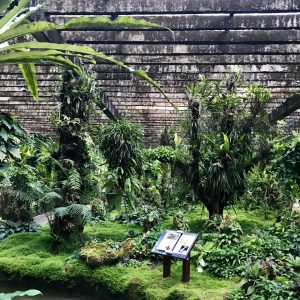
Vanessa Handley, Director of Collections & Research
At the end of last month, I had the pleasure of representing UCBG at the XIX International Botanical Congress in Shenzhen, China. Given that the IBC is only held every six years, it was a much anticipated and heavily attended event. Over 6500 botanists from around the world convened for an intense week of scientific sessions and satellite meetings. The main event was preceded by nomenclature sessions in which delegates adjudicated proposed changes to the International Code of Nomenclature – the system by which newly discovered species are named (or known species renamed). If this is sounding rather dry, it was anything but … the “Olympics of Botany” brings together a diverse and dynamic mix of people – researchers, conservationists, policy makers and other botanical experts – and every day was stimulating and fast paced. In fact, it is hard to adequately summarize the seven extremely packed days. But I’ll give it a shot by describing some of the highlights:
 Undoubtedly, the peak event was the Botanical Garden Forum hosted by Fairy Lake Botanical Garden. During the Forum, leaders from the world’s most influential gardens shared their wisdom on conservation and collections as well as their visions for botanical gardens of the future. This set the stage for lively Q&A and discussion sessions, capped by a wonderful evening reception with traditional music and dance. An important takeaway: building bridges between gardens is crucial. More on that in a moment …
Undoubtedly, the peak event was the Botanical Garden Forum hosted by Fairy Lake Botanical Garden. During the Forum, leaders from the world’s most influential gardens shared their wisdom on conservation and collections as well as their visions for botanical gardens of the future. This set the stage for lively Q&A and discussion sessions, capped by a wonderful evening reception with traditional music and dance. An important takeaway: building bridges between gardens is crucial. More on that in a moment …
Fairy Lake itself was a highlight of the trip. An extraordinary garden (especially considering it was established less than 25 years ago), Fairy Lake includes over 1000 acres of cultivated and natural spaces. Themed areas include a petrified forest display, vast subtropical shade houses, and an eye-popping cycad garden. The latter is complimented by a paleobotany museum with extensive fossil displays. It was impressive to see a living collection so elegantly anchored to an evolutionary narrative. Given the significant cycad collection at UCBG, it was also great to connect with the head of their National Cycad Conservation Center, Dr. Li Nan. I’m excited by the potential for collaboration between our institutions, particularly given the fact they have other taxonomic collections that parallel those at UCBG – i.e. magnolias and ferns. Their fern house was huge, with thousands of accessions in neat, barcoded rows. I could have spent hours exploring this and their other state-of-the-art greenhouses.
 A second important satellite meeting focused on the Global Genome Initiative for Gardens. GGI-Gardens is part of an umbrella initiative to collect and preserve genome-quality tissue samples from across the tree of life. A full description of GGI and its goals deserves a separate post but, for now, I’m proud to say that UCBG will soon become a partner organization. I look forward to contributing materials from our phenomenal living collections to this valuable international project. As a lovely sideline to this meeting, I attended a signing ceremony in which Fairy Lake Botanical Garden and the Dr. Cecilia Koo Botanic Conservation Center in Taiwan established an MOU. Both Gardens are engaged in impressive bioinventory and conservation projects and are eager for international partnerships. I enjoyed speaking with their research leadership and look forward to exploring field/research partnerships.
A second important satellite meeting focused on the Global Genome Initiative for Gardens. GGI-Gardens is part of an umbrella initiative to collect and preserve genome-quality tissue samples from across the tree of life. A full description of GGI and its goals deserves a separate post but, for now, I’m proud to say that UCBG will soon become a partner organization. I look forward to contributing materials from our phenomenal living collections to this valuable international project. As a lovely sideline to this meeting, I attended a signing ceremony in which Fairy Lake Botanical Garden and the Dr. Cecilia Koo Botanic Conservation Center in Taiwan established an MOU. Both Gardens are engaged in impressive bioinventory and conservation projects and are eager for international partnerships. I enjoyed speaking with their research leadership and look forward to exploring field/research partnerships.
This brings me to a parallel theme at IBC. While impressive strides in conservation and basic research were repeatedly evidenced during the IBC, discussion of biodiversity crisis points were also disturbingly common – particularly in developing countries. At multiple junctions, delegates from less developed regions stressed the need for joint ventures; not simply for financial benefit, but also for dissemination of technical skills and expertise. The necessity for “sister garden” relationships between fledgling gardens and those richer in capacity and resources is clear. Equally so, the mutual benefits of reciprocal exchange, collaborative field work and conservation activities. Excellent plenary lectures by luminaries like Peter Raven and Sandra Knapp stressed the need for such concerted international efforts.
In this vein, one of the most inspiring sessions focused on global conservation networks. David Gill of Fauna and Flora International and Nicole Cavender of The Morton Arboretum described their respective Global Trees projects. The speakers’ reports described projects that ranged from local to global in scale and effectively highlighted ways in which integrated conservation efforts can be implemented. More to the point, they charted a course by which UCBG could expand its current conservation work.
Lastly, on the research front, numerous talks focused on the use of next generation molecular methods to unravel cryptic or complex evolutionary relationships between plants. I look forward to applying some of these approaches to UCBG collections … a topic that will be continued in a later post!
